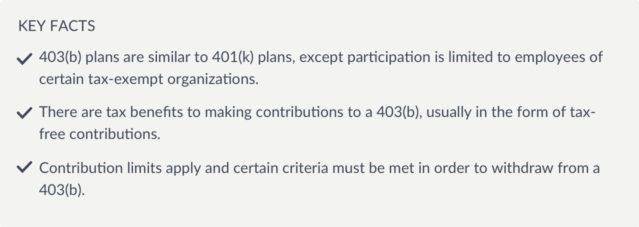What is a 403(b) Plan?
Employer-sponsored retirement plans get a lot of press, but most of the focus is on programs offered by for-profit companies. Fortunately, employees of tax-exempt organizations such as churches, hospitals, and public schools also have a retirement savings option specifically tailored for their needs. Known as a 403(b) plan for the section of tax code that created it, this retirement savings program offers an easy way for participants to set funds aside for the future.
403(b) Retirement Plan Basics
Employers have some flexibility in the details of their 403(b) plan, as long as the program meets certain IRS regulations. First, employers must ensure that employees are eligible to participate in this type of plan. Eligible participants include the following:
- Employees of tax-exempt or 501(c)(3) organizations
- Employees of public school systems, assuming their responsibilities contribute to the daily operation of the school
- Employees of Indian tribal government schools
- Employees of certain hospital service organizations
- Certain ministers
- Civilian faculty and staff working for the Uniformed Services University of the Health Sciences
Next, employers must choose what type of individual accounts will be offered and whether contributions will be made on a traditional pre-tax basis or after-tax basis under the Roth plan design. This usually dictates the type of financial institution that will manage the plan. Options include the following:
- An annuity contract: employees make contributions into an account set up by an insurance company in exchange for the guarantee of regular payments after retirement
- A custodial account: employees make contributions to an account, and the custodian coordinates and manages investment of the contributions in mutual funds
- A retirement income account: employee contributions are invested in annuities or mutual funds
The primary advantage of saving with a 403(b) plan is the corresponding tax benefits. In a standard 403(b) account, income taxes on contributions are deferred. Instead of paying taxes in the year income is earned, taxes are paid when distributions are taken. This is usually after retirement, when participants are typically in lower income tax brackets. If employers choose a 403(b) plan that follows the Roth design, contributions are made with after-tax dollars, and distributions are therefore not taxed.
In addition, some participants might be eligible for the Retirement Savings Contributions Credit (Saver’s Credit), which is designed to encourage low and moderate income taxpayers to contribute to their retirement accounts.
403(b) Contribution Limits
Because of the tax benefits associated with 403(b) contributions, the IRS sets a limit on how much each individual can contribute, as well as the total amount that can be contributed on behalf of each employee. The limits are reviewed each year, and they remained the same between 2015 and 2016.
| 2018 | 2017 | |
| Employee Contribution Limit | $18,500 | $18,000 |
| Catch-Up Contribution Limit for Employees 50 and older | $6,000 | $6,000 |
| Maximum Combined Employee + Employer Contributions | 100% of compensation or $55,000, whichever is less | 100% of compensation or $54,000, whichever is less |
Taking a 403(b) withdrawal
Withdrawing funds from a 403(b) is generally not permitted unless one of the following criteria is met:
- You reach age 59 ½
- You no longer work for the employer that administers the plan
- You have died
- You have become disabled
- You have a financial hardship
- You are eligible for a qualified reservist distribution
When tax-deferred contributions are withdrawn, regular income taxes are assessed. In some situations, a 10% tax penalty may also be applied. Note that you must take required minimum distributions (RMD) when you reach the age of 70 ½.
Disclosure
Nothing in this article should be construed as tax advice, a solicitation or offer, or recommendation, to buy or sell any security. This article is not intended as investment advice, and Wealthfront does not represent in any manner that the circumstances described herein will result in any particular outcome. Financial advisory services are only provided to investors who become Wealthfront clients.
This article is not intended as tax advice, and Wealthfront does not represent in any manner that the outcomes described herein will result in any particular tax consequence. Prospective investors should confer with their personal tax advisors regarding the tax consequences based on their particular circumstances. Wealthfront assumes no responsibility for the tax consequences to any investor of any transaction. Investors and their personal tax advisors are responsible for how the transactions in an account are reported to the IRS or any other taxing authority.
